Complete Solutions to EXERCISE of chapter ELECTRIC CURRENT THROUGH CONDUCTORS of Class 11 book with complete answers and questions
| Class 11 | PHYSICS |
| Chapter | ELECTRIC CURRENT THROUGH CONDUCTORS |
| CHETANA PUBLICATION | EXERCISE |
| Number Of Questions | 100 |
| Academic Year | 2023-24 |
What is the current electricity?
01:20View SolutionWhat happens when a potential difference is applied across the ends of a conductor?
03:10View SolutionDefine electric current. State its S.I. unit and dimension
02:03View SolutionGive the sign convention of electric current.
02:03View SolutionA current 4A flows through an automobile headlight. How many electrons flow through the headlight in a time 2hrs?
02:29View SolutionExplain the concept of drift speed occupied by the electrons in a conductor.
02:56View SolutionDefine current density. State its formula and units.
01:29View SolutionProve that the current density of a metallic conductor is directly proportional to the drift speed of electron.
04:58View SolutionA metallic wire of diameter 0.02m contains 1028 free electrons per cubic meter. Find the drift velocity for free electrons, having an electric current of 100 amperes flowing through the wire.
(Given : charge on electron =` 1.6 xx 10^-19`C)03:16View SolutionThe magnitude of current density in a copper wire is `500 A//cm^2`. If the number of free electrons per `cm^3` of copper is `8.47 xx 10^22`, calculate the drift velocity of the electrons through the copper wire (charge on an e =`1.6 xx 10^-19` C).
03:31View SolutionA copper wire of radius 0.6 mm carries a current of 1A. Assuming the current to be uniformly distributed over a cross sectional area, find the magnitude of current density.
02:04View SolutionState Ohm's law.
02:29View SolutionExplain the resistance of a conductor. State its unit and dimension.
03:14View SolutionDefine S.I. unit of resistance.
01:15View SolutionDraw VI. curve of a conductor.
02:09View SolutionDefine conductance. State its unit and dimension
03:12View SolutionDerive the relation between electric field and current density.
04:06View SolutionShow that σ = \(\frac{ne^2\tau}{m}\). Where symbols have usual meanings.
03:46View SolutionA Flashlight usestwo 1.5V batteries to provide a steady current of 0.5A in the filament. Determine the resistance of the glowing filament.
02:13View SolutionDC current flows in a metal piece of non-uniform cross-section. Which of these quantities remains constant along the conductor current, current density or drift speed? and Why?
06:02View SolutionExplain the limitations of Ohm's law.
03:34View SolutionDistinguish between ohmic substances and non-ohmic substances.
03:54View SolutionDefine the expression for power. State its unit.
05:46View SolutionExplain the heating effect of electric current.
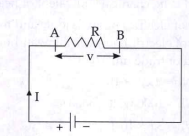 04:15View Solution
04:15View SolutionAn electric heater takes 6A current from a 230V supply line, calculate the power of the heater and electric energy consumed by it in 5 hours.
02:07View SolutionThe heating element connected to 230V draws a current of 5A. Determine the amount of heat dissipated in 1 hour (J = 4.2 J/cal).
03:02View SolutionWhat are resistors? State its types and uses.
01:28View SolutionExplain the colour code system for resistors.
05:08View SolutionFind the value of resistances for the following colour code.
Blue Green Red Gold02:17View SolutionFind the value of resistances for the following colour code.
Brown Black Red Silver02:33View SolutionFind the value of resistances for the following colour code.
Red Red Orange Gold03:17View SolutionFind the value of resistances for the following colour code.
Orange White Red Gold04:32View SolutionFind the value of resistances for the following colour code.
Yellow Violet Brown silver03:42View SolutionFind the colour code for the following value of resistor having tolerance `+-10%`
`330 Omega`03:42View SolutionFind the colour code for the following value of resistor having tolerance `+-10%`
for `100 Omega`01:47View SolutionFind the colour code for the following value of resistor having tolerance `+-10%`
For `47k Omega`01:59View SolutionFind the colour code for the following value of resistor having tolerance `+-10%`
For `160 Omega`01:45View SolutionFind the colour code for the following value of resistor having tolerance `+-10%`
` 1k Omega`01:50View SolutionWrite a note on rheostat.
04:02View SolutionDerive the expression for resistances connected in series.
04:41View SolutionDerive the expression for the resistances connected inparallel.
06:13View SolutionDistinguish between resistance in series and resistance in parallel.
06:27View SolutionCalculate : total resistance and
`R_1 = 3 Omega`, `R_2= 6 Omega`, `R_3 = 5Omega, V = 14 V.
 01:46View Solution
01:46View SolutionCalculate : total Solution: current in the following circuit.
`R_1 = 3 Omega`, `R_2= 6 Omega`, `R_3 = 5 Omega, V = 14 V.
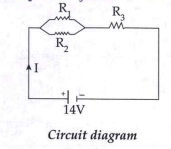 03:20View Solution
03:20View SolutionThree resistors `10 Omega`, `20 Omega` and `30 Omega`` are connected in series combination.
Find equivalent resistance of series combination.01:07View SolutionThree resistors `10 Omega`, `20 Omega` and `31 Omega`` are connected in series combination.
When this series combination is connected to 12V supply, by neglecting the value of internal resistance, obtain potential difference across each resistor03:33View SolutionTwo resistors `1k Omega` and ` 2k Omega` are connected in parallel combination.
Find equivalent resistance of parallel combination.02:05View SolutionTwo resistors `1k Omega` and ` 3k Omega` are connected in parallel combination.
When this parallel combination is connected to 9 V supply, by neglecting internal resistance calculate current through each resistor.03:17View SolutionIn given circuit diagram two resistors are connected to a 5V supply.
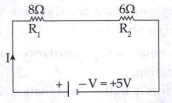
Calculate potential difference across the `8 Omega` resistor.03:29View SolutionIn given circuit diagram two resistors are connected to a 6V supply.
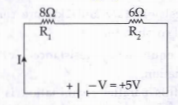 A third resistor is now connected in a parallel with `6 Omega` resistor will the potential difference across the `8 Omega` resistor the larger, smaller or the same as before?
A third resistor is now connected in a parallel with `6 Omega` resistor will the potential difference across the `8 Omega` resistor the larger, smaller or the same as before?
Explain the reason for your answer.03:47View SolutionA battery after a long use has a emf 24V and an internal resistance `380 Omega`. Calculate the maximum current drawn from the battery? Can this battery drive starting motor of car
03:11View SolutionA battery of emf 12 V and internal resistance `3 Omega` is connected to a resistor. If the current in the circuit is 0.5 A,
Calculate resistance of resistor.02:17View SolutionA battery of emf 12 V and internal resistance `3 Omega` is connected to a resistor. If the current in the circuit is 0.6 A,
Calculate terminal voltage of the battery when the circuit is closed.02:29View SolutionState the factors on which the resistance of a given conductor at a particular temperature depends?
02:16View SolutionDefine specific resistance (resistivity). State its unit and dimension.
03:12View SolutionWrite the different formulae of resistivity.
01:54View SolutionDefine conductivity of a material. State its unit and dimension.
02:28View SolutionWrite different formulae of conductivity.
02:00View SolutionCalculate the resistance per metre, at room temperature, of a constantan (alloy) wire of diameter 1.25mm. The resistivity of constant of an at room temperature is `5.0 xx 10^-7 Omega`m.
02:51View SolutionA 6m long wire has diameter 0.5 mm. Its resistance is `50 Omega`. Find the resistivity and conductivity.
02:18View SolutionWhat is the resistance of one of the rails of a railway track 20 km long at `20^@`C? The cross section area of rail is 25 `cm^2` and the rail is made of steel having resistivity at `20^@` C as made of steel having resistivity at `20^@` C as `6 xx 10^-8 Omega`m.
02:57View SolutionExplain the effect of temperature on resistance?
04:09View SolutionExplain the effect of temperature on resistivity.
03:08View SolutionExplain phenomenon of superconductivity.
02:24View SolutionState the applications of superconductivity.
05:30View SolutionA piece of platinum wire has resistance of `2.5 Omega 0^@C`. If its temperature coefficient of resistance is `4 xx 10^-3//^@C`. Find the resistance of the wire at `80^@C`.
02:17View SolutionA silver wire has a resistance of `4.2 Omega` at `27^@C` and resistance `5.4 Omega` at `100^@C`. Determine the temperature coefficient of resistance.
01:42View SolutionDefine : Internal resistance
03:07View SolutionDefine : Electromotive force
02:27View SolutionDefine : Terminal potential differences.
01:26View SolutionState the advantages of cells in series.
02:01View SolutionState the advantages and disadvantages of cells in parallel
01:46View SolutionDerive the expression for `E_eq` and `r_eq` when two cells are connected in parallel.
06:49View SolutionState different types of electrical cells.
04:42View SolutionExplain hydrogen fuel cell vehicles are more environment friendly
02:28View SolutionDistinguish between cells in series and cells in parallel.
05:35View SolutionDistinguish between primary cells and secondary cells.
02:55View SolutionFind the steady curent flowing through a metal wire when `3 xx 10^8` electron pass across a cross-section of the wire in one minute.
(Charge on an electron = `1.6 xx 10^-9`C)01:55View SolutionA current of 800 mA is passed through an electric lamp for one minute. Find the number of electrons passing through it if the charge of electron is `1.6 xx 10^-19` C.
02:52View SolutionWrite down in order the colours of bands for the following carbon resistors:
`10 K Omega`, 10% tolerance04:04View SolutionWrite down in order the colours of bands for the following carbon resistors:
`470 Omega`, 5% tolerance.03:23View SolutionFind the values of the resistors with the following colour code:
Green, White, Yellow, Gold03:51View SolutionFind the values of the resistors with the following colour code:
Grey, Red, Yellow, Silver.03:19View SolutionFind the resistance of a copper cable of length 8 km, diameter 3mm, if its specific resistance is `1.7 xx 10^-8` ohm-metre.
02:55View SolutionCalculate the specific resistance of the material of a wire having a resistance of `4.4 Omega`, length 1.1 m and radius 0.2 mm.
02:22View SolutionA current of 0.4 A flows through a lamp, when a P.D. of 230 V is applied to it. Find the power of the lamp.
01:18View SolutionAn electric lamp is rated 40 W, 100 V. Find the current in the lamp and the resistance of the lamp.
02:50View SolutionThe resistance of a tungsten wire is `1000 Omega` at `0^@C` and `1045 Omega` at `10^@C`. Calculate the temperature coefficient of resistance of tungsten.
02:01View SolutionThe emf of a battery is 21 volt. When it sends a current of 1 ampere through an external resistance, the P.D. across its terminalsfalls to 19 volt. What is the internal resistance of battery?
02:06View SolutionWhat current flowing through a resistance coil of 10 ohm would produce 70 cal/min? J = 4.2 J/cal.
03:09View SolutionCalculate the heat produced per second by an electric heater connected to 240 V mains and carrying a current of 4A.
01:57View SolutionTwo wires A and B of the same material are of uniform cross-section. Wire A is twice as long B and its diameter is thrice that of B. If the resistance of wire A is 10 ohm, find that of wire B.
05:29View SolutionResistance are connected between the points A and B as shown. Find the equivalent resistance between A and B.
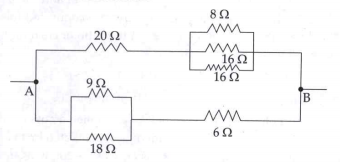 04:08View Solution
04:08View SolutionTwo resistances connected in series have an effective value of `20 Omega`. When connected in parallel, the effective value is `5 Omega`. What are the values of resistance?
03:55View SolutionA wire has a resistance of `6 Omega` at `30^@C` and `6.5 Omega` at `100^@C`. Determine the temperature co-efficient of resistance of the wire. What will be resistance of a wire at 0∘C?
06:12View SolutionA Cell sends a current of 0.5 A through a `2 Omega` resistance. If the resistance is increased by `5 Omega`, the current falls to 0.25 A. Find the emf of the cell and its internal resistance.
05:16View SolutionA wire of circular cross-section and 25 Ω resistance is uniformly stretched until its new length is three times the original length. Find its resistance.
04:53View SolutionThrough a coil of wire of resistance `42 Omega`, a current of 2A is passed for 5 minutes. How much electric charge has flown through the coil? How much heat has been produced?
02:35View SolutionA 75 W lamp is designed to be used on 15 V. What is its resistance? If the lamp is to be used on 120 V, what resistance must be connected in series with it?
04:02View SolutionChoose correct alternative.
You are given four bulbs of 25 W, 40 W, 60 W and 100 W of power, all operating at 230 V. Which of them has the lowest resistance?02:39View Solution
EXERCISE questions and complete solutions for chapter ELECTRIC CURRENT THROUGH CONDUCTORS of CHETANA PHYSICS (MARATHI ENGLISH) of Class 11
